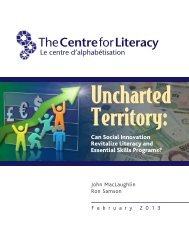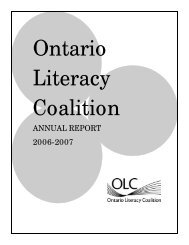You also want an ePaper? Increase the reach of your titles
YUMPU automatically turns print PDFs into web optimized ePapers that Google loves.
Building on the work of Autor, Levy andMurnane, the OECD - through the <strong>PIAAC</strong> survey- is using the categorization of ‘expert thinking’to assess the complex problem solving skillsnecessary for an information-based economy(OECD, 2012). The OECD has developeddiagnostic questions that are used to measureproblem solving abilities directly linked tothe use of ICT in real world contexts. Thisincludes the ability to use digital technology,communication tools and networks, acquire andevaluate information, communicate with othersand perform practical tasks.The assessment of PS-TREs in <strong>PIAAC</strong> is notdesigned to assess and measure specific ICTskills and/or computer or digital literacy – theseskills are presupposed – but instead measuresthe cognitive skills through problem solvingabilities that are used and necessary to functionsuccessfully in today’s information age. Unlikedigital skills and ICT skills, which typically entailthe basic use of devices like a mouse, keyboard,touch screens and other digital displays (e.g.bank machines), the assessment items of PS-TREs are designed to consider the cognitivedimensions of problem solving as the primaryobjective and the use of ICT skills, secondary(OECD, 2012).The PS-TREs element in <strong>PIAAC</strong> is ambitiousin its aims, as it is more than an assessment ofcomputer literacy or digital skills - it is designedto expand our understanding of the depth andcomplexity of cognitive skills used to solveproblems in technology-rich environments.Addressing <strong>Skills</strong>Utilization andMismatch through<strong>PIAAC</strong>information based and skills oriented, skillsrelated policies are increasingly becoming moreprominent and the domain of skills utilizationand/or skill mismatches has become broader(Buchanan, J. et al, 2010).In the past, human capital – a measure of theeconomic value of an employee’s skill set – wasmainly observed through a supply-side lens,with educational credentials and/or qualificationsbeing the main focal point. However, over thepast decade, the focus of human capital hasshifted toward an interest in the analysis ofeducational mismatches to identify whetherworkers and/or the general population wereunder or over-educated in relation to jobs theywere employed in or that were accessible tothem.Furthermore, many academic and policy circlesare now beginning to focus on skills mismatcheswhich includes skills utilization (the actual useof skills needed in the workplace) and demandsidefunctions of the labour market (Desjardins& Rubenson, 2011). In other words, the notionof skills utilization is based on a broaderconceptualization of the skills workers needin their jobs and how, in turn, those skills aredeployed in working environments. This conceptallows for a deeper investigation into the skillsmatches or mismatches and their relationshipto education, sectors, occupations and/or othersocioeconomic factors. Although skills utilizationis a concept that is relatively new and not alwayswell understood by employers and employees,a definition is emerging which attempts to marrythe concept to government policy objectives.The <strong>PIAAC</strong> results are of importance togovernments and industry, as they sharea common interest in developing a betterunderstanding of the relationships betweenskills, education, productivity, economiccompetitiveness and how we can make betteruse of skills. As our economy becomes more4 The <strong>Essential</strong> SKILLS Bulletin 2013 Issue 2




